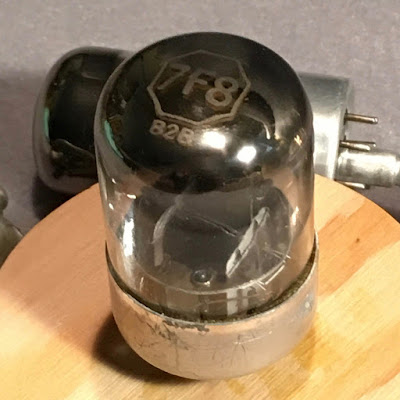Motivated by Ding's octal version of the 834P, I quickly got my hands dirty punching out and painting a chassis.
Loctal tubes
The concept of this project was to build a full function stereo preamp utilizing loctal tubes based on the schematics below.
Preamp circuit
!!!WARNING!!!
The voltages found in this circuit can be lethal!
Build at your own risk!!!
 |
| Power Supply |
 |
| 5AZ4 rectifier = 5Y3 on a loctal base |
Line Stage
 |
| The 7AF7 is very similar to the 7N7 and 6SN7 but has slightly less transconductance and inter-electrode capacitance |
 |
| 7N7 = loctal based 6SN7 |
Phono
The stock EAR 834P circuit (above) used all high-mu 12AX7s with the second stage capacitor coupled to the cathode follower stage. While preparing this blog entry, I remembered that my dearly departed friend, mono aficionado Brian monofantastico Clark, grafted his own interpretation of an EAR 834P phono stage to his SE 801 mono integrated amplifier. He was an active participant in this discussion of 834P modifications initiated by Thorsten Loesch.
Ding's octal version of the 834P uses all 6SL7s with the second stage direct coupled to the cathode follower stage. Without ever sounding harsh, Ding's octal 834P sounded brighter and had a refreshing airiness in the high frequencies compared to my darker and more midrange oriented RCA derived phono preamp. Even if I never heard an original EAR 834P, I now have a good idea why it was received with great enthusiasm.
 |
| 7F7 = 6SL7 on a loctal base |
Although the 7B4 and 7B6 are high-mu loctals, they are single triodes. AFAIK, the 7F7 is the only high-mu twin triode available in loctal and was the obvious choice for the 1st and 2nd stages of the 834P circuit given my chassis configuration.
Tube rolling loctal style
 |
| I've been tweaking and listening to this preamp for the past 6 months. |
During my Dyna PAS hacking days, the 12AU7 always sounded gutsier in line stage and cathode follower applications than the 12AX7 because it had lower Rp and pulled more current. Thus, there was some room to voice the 834P circuit through the cathode follower section.
 |
| Warning: 7F8 is NOT plug-in compatible with the 7N7 and 7AF7 |
I initially set up the phono section to use the unique 7F8 loctal in the cathode follower position, hoping that the 7F8's greater transconductance will produce a darker and more robust sound. But ultimately, it was the ubiquitous 7N7 (loctal 6SN7) that gave me the tonal balance I wanted, with the 7AF7 as alternate.
With an amplification factor of 48, the 7F8 may not have enough gain as a phono preamp with the RIAA EQ in the negative feedback loop. However, it was too much for a zero feedback single stage line amp.
Typically, I don't split halves of twin triodes for left and right channels. I made an exception in wiring this line stage so that I could exploit the 7AF7 vs. 7N7 comparisons and usage options.
My ears finally chose the 7AF7 as the voltage amplifier for the line stage. The slightly lower transconductance and amplification factor mimics the exotic tonal qualities of its grandad, the 76. Each half of the 7AF7 is direct coupled to half of a 7N7 configured as the cathode follower. This combination is as close as I could get to my 76/6SN7 line stage.
But don't limit yourself to this report, use it as a starting point for your loctal tube rolling adventure. 😉
Which is better?
or
Both are here to stay. 😎
🎅🎅🎅 Happy holidays and merry listening! 🎄🎄🎄
















